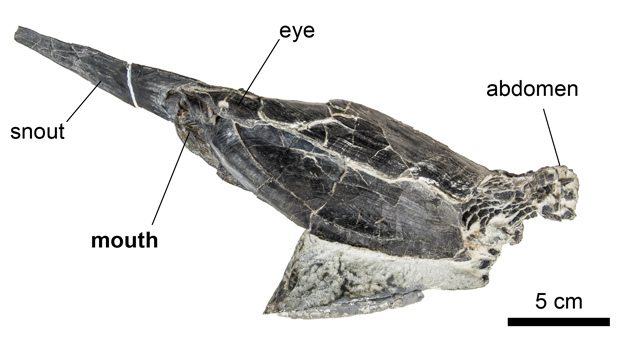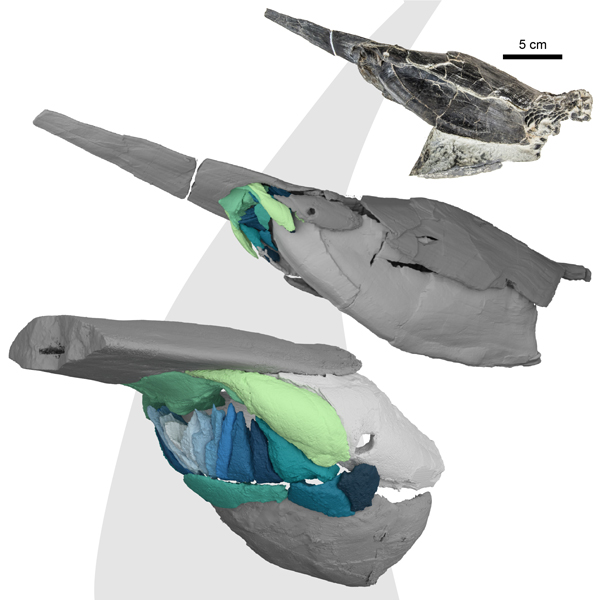New Study of Ancient Jawless Fish Suggests They were Filter-feeders
Newly published research has demonstrated that early, jawless fish (agnathans), used bony plates surrounding their mouths to modify the mouth’s shape whilst feeding. CT scans of a three-dimensionally preserved Rhinopteraspis fossil suggest that these early vertebrates were suspension feeders, not hunters or scavengers. The study, led by scientists from the University of Birmingham helps to improve our understanding of the evolution of feeding ecology. The Devonian pteraspidid heterostracan Rhinopteraspis dunensis, the jawless fish studied, was probably a nektonic filter-feeder.

The anterior portion of a three-dimensionally preserved Rhinopteraspis dunensis specimen. CT scans of the fossilised remains of this Devonian fish enabled scientists to study feeding ecology. Picture credit: University of Birmingham.
Studying the Feeding Behaviours of Early Vertebrates
Scientists often use the inferred feeding behaviours of early vertebrates to help piece together the evolution of Vertebrata. Different jaw morphologies and jaw composition can suggest a wide range of feeding strategies. In the jawless fishes many competing theories have been proposed for their feeding habits. For example, scientists have examined whether these animals were passive feeders or active hunters.
A new paper, published in the Proceedings of the Royal Society B reconstructs the feeding apparatus of the Devonian pteraspidid Rhinopteraspis dunensis. Computerised tomography enabled the research team to construct 3D models of the fish’s mouth. The images revealed the structure and arrangement of finger-like bones that project from the lower “lip” of the animal’s mouth. The researchers suggest that these projections controlled the mouth’s size and shape as it filtered food particles from the water.
Senior author and project lead Dr Ivan Sansom (University of Birmingham) stated:
“The application of CT scanning techniques to the study of fossil fish is revealing so much new information about these ancient vertebrates and giving us the opportunity to study precious and unique specimens without destructive investigation.”

Three-dimensional reconstruction of the oral region of Rhinopteraspis dunensis (NHMUK PV P 73217). Picture credit: University of Birmingham.
A Remarkable Rhinopteraspis Fossil
The Rhinopteraspis fossil used in the study is part of the London Natural History Museum fossil collection. It is specimen number NHMUK PV P 73217. It consists of an almost complete anterior portion of the animal. The entire headshield is present along with body scales. Although the Rhinopteraspis fossil has been compressed laterally, elements associated with the oral cavity appear to have maintained their original shape and relative location.
Dr Richard Dearden (University of Birmingham) and lead author of the study explained:
“In this case, these methods have allowed us to fit all of the small bones of this animal’s mouth together, and try and understand how it fed from this integrated system rather than by using isolated bones. Instead of a steady trend towards ‘active food acquisition’ – scavenging or hunting – we see a real diversity and range of feeding behaviours among our earliest vertebrate relatives.”
To read a related article that questioned whether heterostracans were suspension feeders: New Study Features Extremely Old Vertebrate.
Bony Plates with Limited Movement
The mineralised plates around the mouth had limited movement. It is unlikely that these early vertebrates were hunters capable of biting. Many Pteraspidiformes had elongated, bony snouts this would have made it difficult to strain food particles from sediment. However, the mouth plates would have allowed it to control the opening of the mouth, and perhaps strain food from water in a way also used by animals such as flamingos or mussels.
This new study offers a new perspective on the evolution of feeding strategies in early vertebrates. Many current hypotheses argue that there was a long-term evolutionary trend away from passive food collection and consumption to predatory behaviour. This research challenges these earlier theories and suggests that primitive fish had a broad range of different feeding behaviours long before the evolution of a jaw structure.
Everything Dinosaur acknowledges the assistance of a media release from the University of Birmingham in the compilation of this article.
The scientific paper: “The three-dimensionally articulated oral apparatus of a Devonian heterostracan sheds light on feeding in Palaeozoic jawless fishes” by Richard P. Dearden, Andy S. Jones, Sam Giles, Agnese Lanzetti, Madleen Grohganz, Zerina Johanson, Stephan Lautenschlager, Emma Randle, Philip C. J. Donoghue and Ivan J. Sansom published in the Proceedings of the Royal Society B.
The Everything Dinosaur website: Prehistoric Animal Models and Figures.

